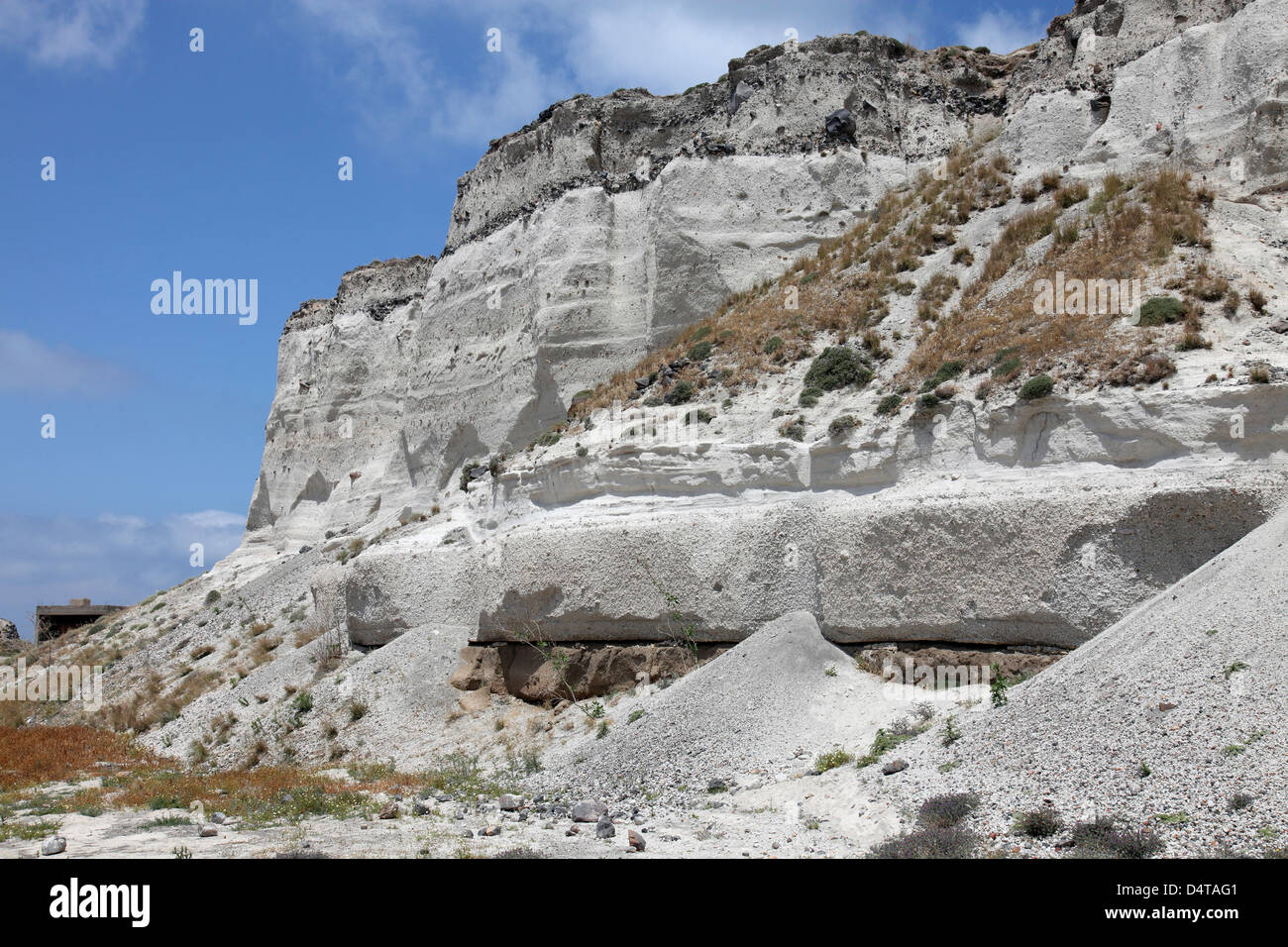Minoan Eruption

The Minoan eruption, a cataclysmic event that occurred approximately 3,600 years ago, holds immense significance in the historical and geological records of the Mediterranean region. This eruption, originating from the Thera volcano on the island of Santorini, is considered one of the most influential volcanic events in human history. It had far-reaching implications, shaping the course of civilizations and leaving an indelible mark on the geological landscape.
The Scale and Impact of the Minoan Eruption

The magnitude of the Minoan eruption was unprecedented. It is estimated that the volcano released a staggering amount of magma, resulting in a violent explosion that spewed ash, pumice, and gases into the atmosphere. The eruption column reached heights of up to 36 kilometers (22 miles), spreading volcanic material across a vast area. The ensuing pyroclastic flows and tsunamis devastated the surrounding islands and coastal regions, causing widespread destruction and reshaping the geological features of the Aegean Sea.
The impact of the eruption extended beyond the immediate vicinity. Volcanic ash and tephra were deposited across the Mediterranean, affecting regions as far as Egypt, Syria, and even parts of modern-day Turkey. The atmospheric disturbances caused by the eruption are believed to have influenced climate patterns, potentially leading to cooler temperatures and altered weather conditions in various parts of the world. The aftermath of the eruption left a lasting legacy, both in the form of geological deposits and in the societal and cultural transformations it triggered.
Unraveling the Minoan Eruption: Scientific Investigations

Scientific interest in the Minoan eruption has fueled extensive research and archaeological investigations. Geologists, volcanologists, and archaeologists have collaborated to piece together the events leading up to and following the eruption. By analyzing volcanic deposits, studying geological formations, and examining archaeological remains, researchers have gained valuable insights into the eruption’s chronology, intensity, and impact.
One notable aspect of the scientific inquiry is the study of the volcanic deposits on Santorini. The thick layers of pumice and ash, known as the "Pumice-Tuff Ring," provide a detailed record of the eruption's phases. These deposits offer clues about the magnitude and duration of the eruption, allowing scientists to reconstruct the sequence of events and estimate the volume of material expelled.
Archaeological excavations on Santorini and surrounding islands have also yielded significant findings. The ruins of the ancient city of Akrotiri, buried under volcanic ash, offer a unique glimpse into the advanced civilization that inhabited the island before the eruption. The well-preserved structures and artifacts provide valuable information about Minoan culture, architecture, and daily life, shedding light on the societal changes and challenges faced in the aftermath of the eruption.
The Legacy and Implications of the Minoan Eruption
The Minoan eruption had profound consequences for the Minoan civilization, which flourished on the island of Crete and across the Aegean. The eruption is believed to have dealt a devastating blow to Minoan settlements, disrupting trade networks, causing population displacement, and potentially leading to the decline of the Minoan culture. The societal and economic impacts were far-reaching, influencing the course of history in the Mediterranean region.
The eruption's aftermath also triggered geological transformations. The collapse of the Thera volcano led to the formation of a large caldera, creating the distinctive shape of Santorini as we know it today. The volcanic activity and the resulting caldera formation reshaped the landscape, giving rise to unique geological features that have become iconic symbols of the island.
Moreover, the eruption's influence extended beyond the Aegean. The widespread dispersal of volcanic ash and the potential atmospheric effects have been linked to various historical and cultural events. Some researchers suggest that the eruption may have contributed to the decline of the Egyptian Middle Kingdom and influenced the course of ancient civilizations in the Eastern Mediterranean. The eruption's legacy continues to spark debates and inspire further research, as scientists and historians strive to unravel its full impact on human history.
The Volcano’s Geological Profile
The Thera volcano, also known as the Santorini volcano, is a complex volcanic system comprising multiple centers and vents. It is classified as a stratovolcano, characterized by its layered structure of lava flows, ash, and pyroclastic deposits. The volcano’s activity is part of the larger Aegean Volcanic Arc, which is associated with the subduction of the African Plate beneath the Eurasian Plate.
The Minoan eruption was not the only significant event in the volcano's history. Throughout its long geological record, the Thera volcano has experienced multiple eruptions, each leaving its mark on the island and the surrounding region. The most recent eruption, which occurred in 1950, was a relatively small event compared to the Minoan eruption but served as a reminder of the volcano's ongoing activity.
The Thera volcano is closely monitored by scientists, who study its behavior and potential hazards. Advanced monitoring systems, including seismometers, GPS, and gas emission sensors, provide valuable data on volcanic activity and help assess the risk of future eruptions. By understanding the volcano's geological profile and monitoring its activity, researchers can better predict and mitigate the impacts of future volcanic events.
Volcanic Hazards and Risk Assessment
The Thera volcano presents various hazards, including volcanic ashfall, pyroclastic flows, lahars, and potential tsunamis. Volcanic ash can disrupt aviation, affect human health, and impact agricultural activities. Pyroclastic flows, composed of hot gases and volcanic material, pose a significant threat to nearby communities and infrastructure. Lahars, which are volcanic mudflows, can occur during or after an eruption, carrying debris and causing widespread damage.
Risk assessment plays a crucial role in managing the potential hazards associated with the Thera volcano. Scientists and disaster management experts collaborate to develop hazard maps, early warning systems, and evacuation plans. By studying the volcano's past behavior, monitoring its current activity, and analyzing the vulnerability of surrounding areas, they can provide valuable insights and recommendations to mitigate the impacts of future eruptions.
| Hazard | Potential Impact |
|---|---|
| Volcanic Ashfall | Disruption of air traffic, health risks, agricultural impacts |
| Pyroclastic Flows | Destructive to nearby settlements and infrastructure |
| Lahars (Volcanic Mudflows) | Causes widespread damage and inundation |
| Tsunamis | Potential for coastal flooding and destruction |

Lessons from the Past: Implications for the Future

The Minoan eruption serves as a powerful reminder of the impact volcanic events can have on human societies and the environment. It highlights the need for comprehensive volcanic hazard assessment, early warning systems, and disaster preparedness. By studying the past, scientists and policymakers can better understand the potential consequences of future eruptions and implement effective strategies to minimize their impact.
The lessons learned from the Minoan eruption have influenced volcanic hazard management and disaster response globally. Advanced monitoring technologies, improved communication systems, and enhanced community education and awareness programs have been developed to address volcanic risks. The study of past eruptions, such as the Minoan event, continues to provide valuable insights and guide the development of more resilient communities and infrastructure.
Moreover, the scientific investigations surrounding the Minoan eruption have advanced our understanding of volcanic processes and their long-term effects. The analysis of volcanic deposits, the study of past civilizations, and the integration of geological and archaeological data have contributed to a more comprehensive knowledge base. This knowledge not only helps us better comprehend the past but also enables us to make more informed decisions and prepare for future volcanic events.
Community Resilience and Preparedness
Building community resilience is a key aspect of mitigating the impacts of volcanic eruptions. By engaging with local communities, providing education and training, and fostering a culture of preparedness, individuals and communities can better respond to volcanic hazards. Community-based initiatives, such as evacuation drills, emergency response plans, and vulnerability assessments, play a crucial role in ensuring the safety and well-being of residents.
The development of effective communication strategies is also vital. Clear and timely dissemination of information about volcanic activity, potential hazards, and evacuation procedures can save lives. Utilizing multiple communication channels, including social media, local radio, and community networks, ensures that vital information reaches all members of the community, including those with limited access to technology or language barriers.
What caused the Minoan eruption, and how did it impact the Minoan civilization on Crete?
+The Minoan eruption was caused by the buildup of magma beneath the Thera volcano, leading to a catastrophic explosion. The eruption had a devastating impact on the Minoan civilization on Crete, disrupting trade, causing population displacement, and potentially contributing to the decline of Minoan culture.
How does the Minoan eruption compare to other volcanic events in terms of magnitude and impact?
+The Minoan eruption is considered one of the most influential volcanic events in human history due to its scale and impact. It ranks among the largest eruptions in the past few millennia, rivaling other significant eruptions such as the eruption of Krakatoa in 1883 and Mount Tambora in 1815.
What are the long-term effects of the Minoan eruption on the environment and climate?
+The Minoan eruption’s long-term effects on the environment and climate are still being studied. It is believed that the eruption’s atmospheric disturbances influenced climate patterns, potentially leading to cooler temperatures and altered weather conditions in various parts of the world. The volcanic ash and tephra deposited across the Mediterranean also had ecological impacts on marine and terrestrial ecosystems.


